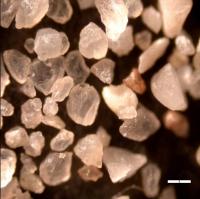Granular materials: Sand and soil
When a fire occurs in a sandy forest the soil can become naturally extremely water-repellent (see Stefan Doerr's website here). This leads to erosion when it rains and difficulty in re-establishing vegetation and, in the extreme case, impressively destructive debris torrents (click here to see a video). But what does this have to do with superhydrophobicity? The fire volatizes waxes from the litter layer and these then re-condense on the grains of sand. Since the grains of sand with gaps in-between provide a rough surface and the waxes are hydrophobic this creates a superhydrophobic surface. The same process (on a smaller scale) can be used in the laboratory with grains or beads stuck to a solid substrate. Read more about the similarities between superhydrophobic materials and extreme soil water repellency in the publication below.
Publications
![]()
Water repellent soil and its relationship to texture and hydrophobicity,
Eur. J. Soil Sci. 56 (4) (2005) 445-452.
View postprint pdf
![]()
Superhydrophobic surfaces: A model approach to predict contact angle and surface energy of soil particles,
Eur. J. Soil Sci. 60 (3) (2009) 420-430.
View postprint pdf



